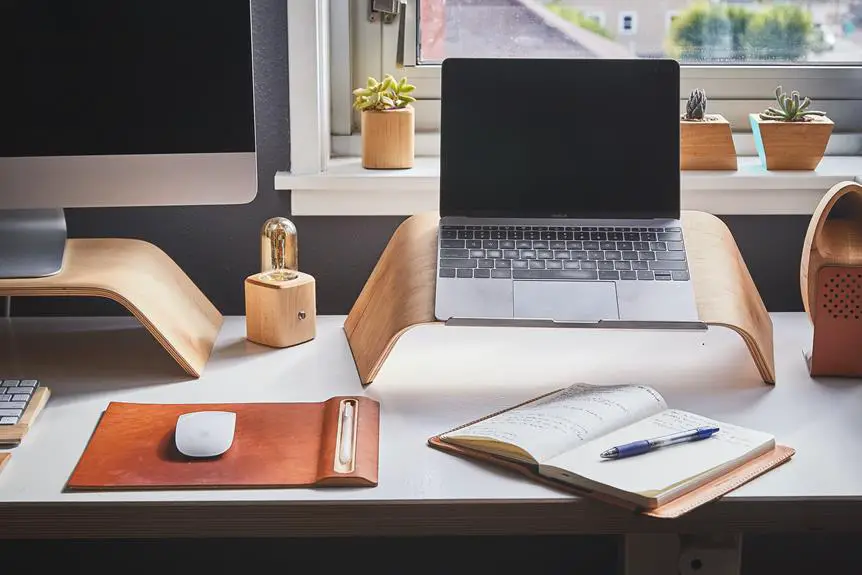If you're like 87% of professionals who now work from home at least part of the time, you understand the importance of creating an optimal home office setup. Mastering the art of monitor placement and display arrangement can significantly enhance your productivity and comfort.
This guide will walk you through the essential steps to create the best monitor setups for your home office. From choosing the right monitors to managing cables and accessories, you'll learn how to design a workspace that maximizes efficiency and minimizes strain.
Whether you're a seasoned remote worker or transitioning to a home office, mastering your monitor setup is key to achieving peak performance.
Key Takeaways
- Consider the size and resolution that will suit your work needs
- Adjust the height and distance of your monitor to minimize strain
- Maximize space by using monitor mounts or stands
- Efficient multitasking by working on different tasks simultaneously
Choosing the Right Monitors
Choose the best monitors for your home office setup based on the size and resolution that will suit your work needs. When it comes to monitor resolution, higher resolutions such as 4K or ultra-wide quad HD (UWQHD) provide sharper images and more screen real estate for multitasking. If you work with detailed graphics or videos, a higher resolution monitor is crucial for an optimal viewing experience.
However, if your work primarily involves text-based tasks, a standard full HD (1920 x 1080) monitor might suffice. Consider the screen size as well. A larger screen offers more workspace and enhances productivity, especially when working with multiple windows simultaneously. On the other hand, a smaller screen size might be more suitable for a compact workspace or if you only need to focus on one task at a time.
Ultimately, the ideal monitor for your home office setup depends on the nature of your work and your personal preferences. Selecting the right combination of monitor resolution and screen size is essential in creating a comfortable and efficient working environment.
Ergonomic Monitor Placement
To ensure proper ergonomic monitor placement in your home office, regularly adjust the height and distance of your monitor to minimize strain on your neck and eyes. Position the top of the monitor at or slightly below eye level, roughly an arm's length away. This helps reduce the need to tilt your head up or down, preventing neck strain. Additionally, make sure the monitor is directly in front of you to avoid twisting your neck or torso.
| Adjusting Height | Reducing Glare |
|---|---|
| Position the top of the monitor at or slightly below eye level. | Place the monitor to the side of windows to reduce glare. |
| Ensure the monitor is an arm's length away. | Use an anti-glare screen or adjust the monitor angle to minimize glare. |
| Align the monitor directly in front of you. | Adjust the brightness and contrast settings to reduce glare. |
Optimizing Display Arrangement
For the most effective home office monitor setup, position multiple displays to create a cohesive and efficient workspace.
When optimizing display arrangement, maximizing space is crucial. Consider using monitor mounts or stands to elevate screens and free up valuable desk space. This allows for a more organized and spacious environment, promoting productivity and reducing clutter.
Additionally, arranging displays in a way that minimizes glare is essential for a comfortable and visually clear workspace. Position monitors at a slight tilt to reduce reflections from surrounding light sources, and consider investing in anti-glare screen protectors if glare remains an issue. By strategically placing your monitors to minimize glare, you can ensure that your work isn't disrupted by distracting reflections or visual discomfort.
Ultimately, the goal of optimizing display arrangement is to create a seamless and ergonomic setup that maximizes efficiency and minimizes visual distractions.
Enhancing Productivity With Multiple Monitors
When you have multiple monitors in your home office setup, you can enhance your productivity by seamlessly transitioning between tasks and applications. With multiple monitors, you can significantly increase focus and reduce distractions.
Here's how you can benefit from multiple monitors:
- Efficient multitasking: Picture effortlessly working on a spreadsheet on one screen while referencing data from a website on another. This setup allows you to seamlessly switch between tasks without the need to constantly minimize and maximize windows.
- Enhanced organization: Imagine having your email, calendar, and project management tool open on separate screens. This layout provides a clear visual separation of different work streams and helps you stay organized and focused on each task.
- Streamlined research and comparison: Envision conducting research on one screen while simultaneously comparing products, services, or data on another. This setup eliminates the need to constantly toggle between tabs, making your research process more efficient and less prone to distractions.
Managing Cables and Accessories
Maximizing the efficiency of your home office monitor setup involves managing cables and accessories effectively. Proper cable management and desk organization not only contribute to a clean and professional workspace but also help in improving productivity. To streamline your setup, consider incorporating the following cable management and desk organization accessories:
| Cable Management | Desk Organization |
|---|---|
| Cable sleeves | Desk organizers |
| Cable clips | Drawer organizers |
| Cable trays | Monitor stands |
Cable sleeves provide a neat and organized way to bundle and conceal cables, creating a clutter-free environment. Cable clips can be used to secure and route cables along the edges of your desk, keeping them easily accessible but out of the way. Cable trays are ideal for managing power strips and excess cables, preventing them from cluttering your workspace. In terms of desk organization, investing in desk organizers and drawer organizers can help keep essential items within reach and reduce visual distractions. Additionally, using monitor stands not only elevates your monitors to eye level but also creates space underneath for storing keyboards and other accessories. By implementing these cable management and desk organization solutions, you can create a more efficient and aesthetically pleasing home office setup.
Frequently Asked Questions
What Are Some Budget-Friendly Options for Setting up a Multi-Monitor Display at Home?
Looking for budget-friendly, ergonomic setups for your home office? Consider multi-monitor displays for increased productivity. Use adjustable mounts for optimal viewing angles. Utilize affordable monitor arms for space efficiency. These tips can enhance your work environment.
Are There Any Specific Monitor Brands or Models That Are Best for Reducing Eye Strain During Long Work Hours?
To reduce eye strain, consider top monitor brands like BenQ or Dell with flicker-free technology and low blue light emission. Position monitors at eye level, use anti-glare screens, and take regular breaks to rest your eyes.
Can I Use Different Sized Monitors in My Multi-Monitor Setup, or Should They All Be the Same Size?
You can use different sized monitors in your multi-monitor setup, but there are pros and cons. Best practice for mixed monitor sizes is to align the top or bottom edges for a seamless viewing experience.
Are There Any Software or Apps That Can Help Me Customize and Manage My Multi-Monitor Display?
You can enhance your multi-monitor setup with monitor management software options that allow customizing display. Explore apps available for seamless management and customization. Maximize your display potential and boost productivity with these powerful tools.
What Are Some Creative Ways to Hide or Organize the Cables and Accessories in My Home Office Setup?
To organize accessories in your home office setup, get creative with cable management. Use cable clips, zip ties, or cable sleeves to keep things tidy. Consider a cable box or desk grommet to hide cables. Keep it neat and efficient.




